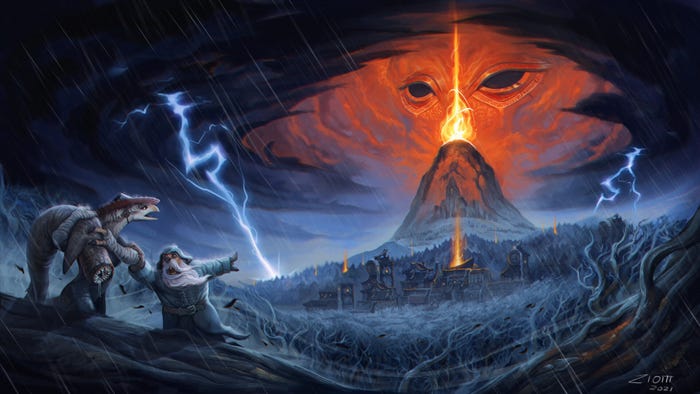At the 2007 GCDC in Leipzig, the original Ensemble studio team of Tony and Rick Goodman, Brian Sullivan and Bruce Shelley reunited to discuss the conception, development and creative process of their long-running best-seller Age of Empires in a re
August 23, 2007

Author: by Rene Sickel, Leigh Alexander
At GCDC, the keynote Age of Empires retrospective reunited Ensemble studio head Tony Goodman, lead designer Rick Goodman, designer Brian Sullivan, and designer Bruce Shelley. In a panel moderated by IGN's Steven Butts, they looked back on the best-selling game and discuss its storied history. The panel was asked what makes Age special. "Our idea started at the time when Warcraft and Command & Conquer came out," Shelley explained. "The idea was to take some ideas from these games and mix it with some elements from civilization and history." "On the whole list of RTS games that came out at that time, Age was the only one with a historical theme," Sullivan added. Describing why Age has such a wide casual fan base, Shelley said, "Every one of our design decisions had to work for both casual and hardcore audiences. So with the Rock-Paper-Scissor differentiation for hardcore, you would make scissors five times stronger than paper -- but in casual, it would just be two times stronger." "We just started off with the fanbase Bruce and Sid Meyer already had with Civilization. At the time, when we got Microsoft as publisher, nobody really had a reference for a historical game," Goodman said. He continued: "Every artist wants to create something that hasn't been there before. History was a good decision, and there were a lot people around that liked history as well. So everybody got the story, and we didn't have to create units like other RTS games, because the units were already lying around." On how the content that made it in was determined, Shelley explained: "We pushed back from the idea of putting all the history of the world in just one game. Only a few ages [was] a good, manageable step to do." But what about too much historical accuracy in the game? "Well, we always go for the fun," Shelley said. "There was this vast area from history, so we just had to pick out which [historical elements] would make a great game. Other things, like slavery -- we didn't know how to work [in] slavery, so we left it out." Did the game change over time? "Bruce always tended to step back, and would give one comment in the end and everybody would go, 'oh, yeah...'" Goodman recalled. "Rick came in, and had a really ambitious game in mind, and Brian's goal was to get the game back in size." Butts asked how it was that the team managed to be developers and business people at the same time. "We have spent many years developing technology, so we had the management skills which made us very efficient," Sullivan answered. On how the next step to Age of Kings was taken, Shelley explained: "We basically went into a big room, and applied what we learned in Age 1." And what were those lessons? The team developed a philosophy: to pick a narrow topic that could be described in a single sentence, and to make those topics discrete -- a game about knights and castles would be easy to understand, they concurred. Shelley added that Starcraft was one of the games that came out between Ages 1 and 2 that influenced the team's work. "They really differentiated their civilizations, and we also went on to doing that," he said. "Also, a lot of Age 2 stuff was things we hadn't worked out in Age 1." Added Sullivan: "Before shipping Age 1, we had a five-page list of things we wanted in Age 1, and we realized only half a page. so we had a lot of stuff for Age 2. Butts asked the panel about the kinds of decisions they made for Mythology. "We were really getting tired of drawing knights and castles," Sullivan recalled. "There was the whole business side of this," Goodman said. It was doing the game you have been doing for a while versus doing something new, so we told Microsoft, 'either let us do something different or fire us.' But because Microsoft owned the IP, we wanted to do something with "Age of" in it." "Mythology was 3D, and that offered the opportunity to do many new things," Shelley added. "You could grab the earth and shake it, and stuff like that. Recalled Goodman: "We had a demo with the whole earthquake scene, and showed it to Gates and he went like, '...hmmm, okay'." Butts recalled how the first screenshots of Age 3 were so lifelike he disbelieved them. "Yeah, the 3D graphics made it easier for us to convince people that this is a real place in history," Shelley said. On big innovations in Age 3, Shelley described: "The biggest innovation was probably the home city. It was sort of a RPG character which became better throughout the game. We differentiated with the topic and the graphics, and when it came out it had a lot of features that were new, like randomly generated levels." So what's on the horizon for the series? Busy with Halo Wars now, the team doesn't want to juggle two strategy franchises simultaneously. Still, Shelley hasn't stopped looking toward the future. "There is a lot of room for Age," he says. "We can go into space, for instance."
You May Also Like







